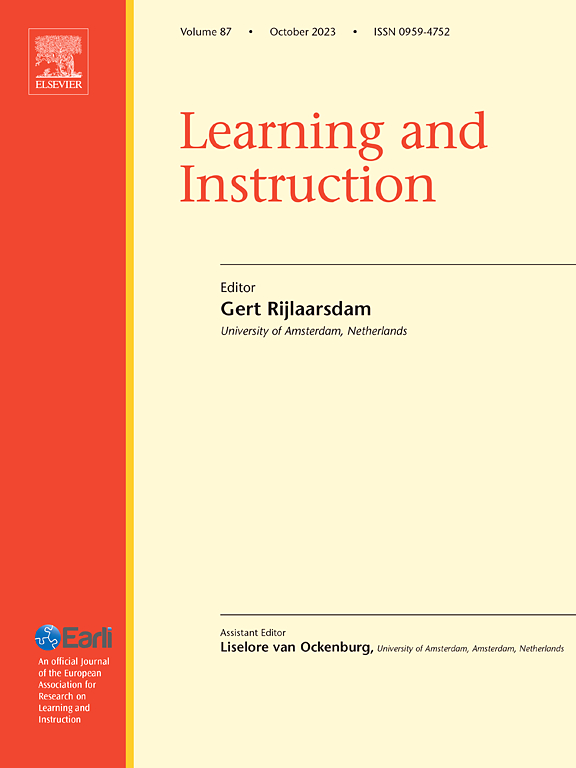使用交错练习促进拼写习得
IF 4.9
1区 教育学
Q1 EDUCATION & EDUCATIONAL RESEARCH
引用次数: 0
摘要
背景:与阻挡相同的样本相比,来自不同类别的样本相互交错更倾向于改善类别学习。然而,当使用语言材料进行学习时,交错的有效性是不确定的。此外,在实际教育环境和拼写教学背景下对交错的研究很少。目的我们报告了一个预先注册的课堂实验的结果(https://aspredicted.org/BZH_BTC),该实验检查了交错学习拼写规则的好处。这项研究涉及108名德国三年级学生。方法儿童接受两次训练,分别练习与特定拼写规则相关的单词(即大写字母,单个和多个辅音,或带有“i”和“ie”的单词),其中一次训练采用封锁格式,另一次训练采用交错格式。学习结果在训练后不久和8周后测量,以衡量交错对持续学习的影响。结果:儿童在交错模式下的拼写错误比在封闭模式下的拼写错误要少。这种交错的好处在8周的随访中持续存在,对于那些对单词拼写有平均到较高先验知识的孩子来说,训练过的单词和新单词。与受阻练习阶段相比,孩子们在交错练习阶段犯了更多的拼写错误,认为交错练习更困难,并且认为他们的学习过程比受阻练习更不成功,这支持了交错练习是一种理想难度的假设。结论留置式练习是一种促进拼写规则习得的有效方法,尤其适用于有较好先验知识的儿童。本文章由计算机程序翻译,如有差异,请以英文原文为准。
Using interleaved practice to foster spelling acquisition
Background
Interleaving exemplars from different categories tends to improve category learning compared to blocking the same exemplars. However, the effectiveness of interleaving is uncertain when verbal materials are employed for learning. Moreover, research on interleaving in real educational settings and in the context of spelling instruction is scarce.
Aims
We report the results of a preregistered classroom experiment (https://aspredicted.org/BZH_BTC) that examined the benefits of interleaving for learning spelling rules.
Sample
The study involved 108 German third graders.
Method
Children received two training sessions in which they practiced words associated with specific spelling rules (i.e., capitalization, single and multiple consonants, or words with “i” and “ie”), with one session following a blocked and the other an interleaved format. Learning outcomes were measured shortly after the training and after 8 weeks to gauge effects of interleaving on lasting learning.
Results
Children showed fewer spelling errors when they practiced exemplars in an interleaved than a blocked sequence for words trained in the sessions. This interleaving benefit persisted after an 8-week follow-up for the trained and new words for children with average to high prior knowledge of word spellings. Children made more spelling errors during the interleaved compared to the blocked practice phase, perceived interleaved practice as more difficult, and rated their learning process as less successful compared to blocked practice, supporting the assumption that interleaved practice is a desirable difficulty.
Conclusions
Interleaved practice is a promising approach to boost the acquisition of spelling rules, particularly among children with better prior knowledge.
求助全文
通过发布文献求助,成功后即可免费获取论文全文。
去求助
来源期刊

Learning and Instruction
Multiple-
CiteScore
11.30
自引率
4.80%
发文量
109
期刊介绍:
As an international, multi-disciplinary, peer-refereed journal, Learning and Instruction provides a platform for the publication of the most advanced scientific research in the areas of learning, development, instruction and teaching. The journal welcomes original empirical investigations. The papers may represent a variety of theoretical perspectives and different methodological approaches. They may refer to any age level, from infants to adults and to a diversity of learning and instructional settings, from laboratory experiments to field studies. The major criteria in the review and the selection process concern the significance of the contribution to the area of learning and instruction, and the rigor of the study.
 求助内容:
求助内容: 应助结果提醒方式:
应助结果提醒方式:


